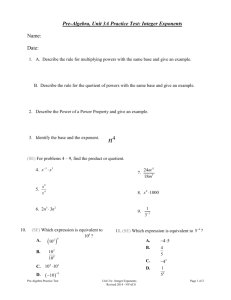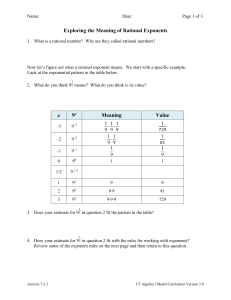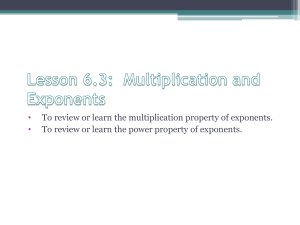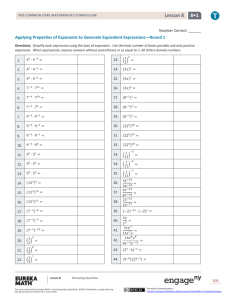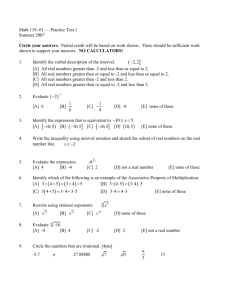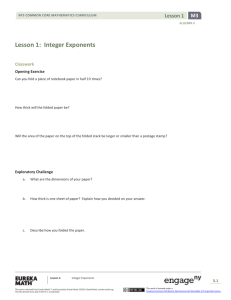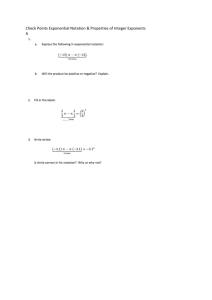Lesson 1: Integer Exponents
advertisement
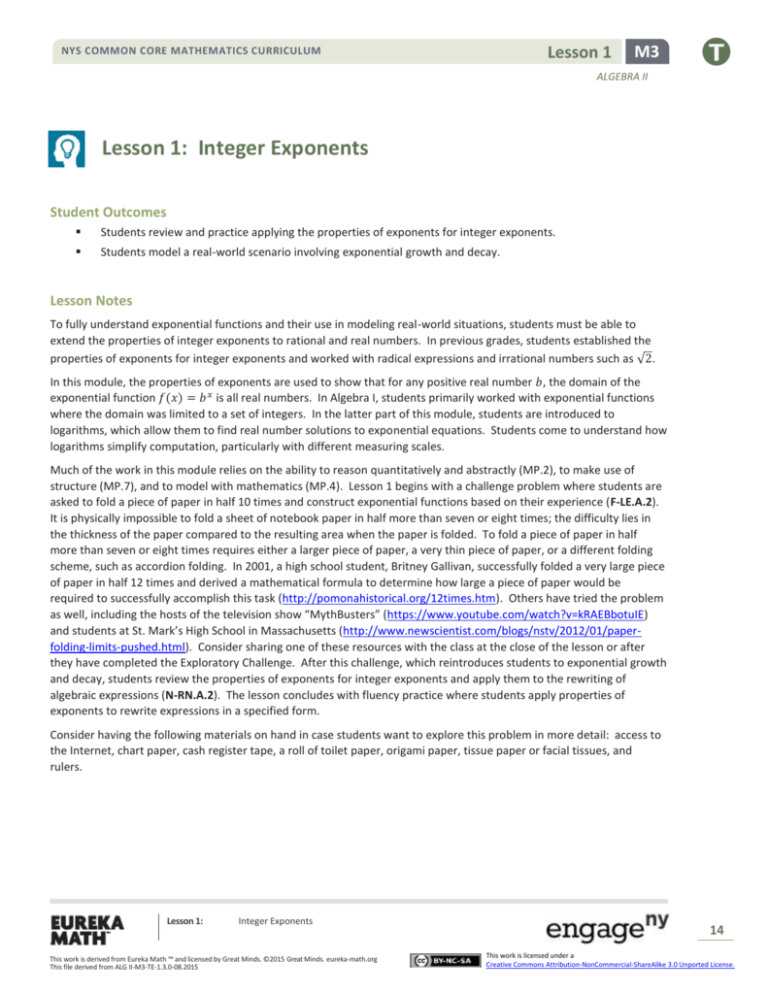
Lesson 1 NYS COMMON CORE MATHEMATICS CURRICULUM M3 ALGEBRA II Lesson 1: Integer Exponents Student Outcomes Students review and practice applying the properties of exponents for integer exponents. Students model a real-world scenario involving exponential growth and decay. Lesson Notes To fully understand exponential functions and their use in modeling real-world situations, students must be able to extend the properties of integer exponents to rational and real numbers. In previous grades, students established the properties of exponents for integer exponents and worked with radical expressions and irrational numbers such as √2. In this module, the properties of exponents are used to show that for any positive real number 𝑏, the domain of the exponential function 𝑓(𝑥) = 𝑏 𝑥 is all real numbers. In Algebra I, students primarily worked with exponential functions where the domain was limited to a set of integers. In the latter part of this module, students are introduced to logarithms, which allow them to find real number solutions to exponential equations. Students come to understand how logarithms simplify computation, particularly with different measuring scales. Much of the work in this module relies on the ability to reason quantitatively and abstractly (MP.2), to make use of structure (MP.7), and to model with mathematics (MP.4). Lesson 1 begins with a challenge problem where students are asked to fold a piece of paper in half 10 times and construct exponential functions based on their experience (F-LE.A.2). It is physically impossible to fold a sheet of notebook paper in half more than seven or eight times; the difficulty lies in the thickness of the paper compared to the resulting area when the paper is folded. To fold a piece of paper in half more than seven or eight times requires either a larger piece of paper, a very thin piece of paper, or a different folding scheme, such as accordion folding. In 2001, a high school student, Britney Gallivan, successfully folded a very large piece of paper in half 12 times and derived a mathematical formula to determine how large a piece of paper would be required to successfully accomplish this task (http://pomonahistorical.org/12times.htm). Others have tried the problem as well, including the hosts of the television show “MythBusters” (https://www.youtube.com/watch?v=kRAEBbotuIE) and students at St. Mark’s High School in Massachusetts (http://www.newscientist.com/blogs/nstv/2012/01/paperfolding-limits-pushed.html). Consider sharing one of these resources with the class at the close of the lesson or after they have completed the Exploratory Challenge. After this challenge, which reintroduces students to exponential growth and decay, students review the properties of exponents for integer exponents and apply them to the rewriting of algebraic expressions (N-RN.A.2). The lesson concludes with fluency practice where students apply properties of exponents to rewrite expressions in a specified form. Consider having the following materials on hand in case students want to explore this problem in more detail: access to the Internet, chart paper, cash register tape, a roll of toilet paper, origami paper, tissue paper or facial tissues, and rulers. Lesson 1: Integer Exponents This work is derived from Eureka Math ™ and licensed by Great Minds. ©2015 Great Minds. eureka-math.org This file derived from ALG II-M3-TE-1.3.0-08.2015 14 This work is licensed under a Creative Commons Attribution-NonCommercial-ShareAlike 3.0 Unported License. Lesson 1 NYS COMMON CORE MATHEMATICS CURRICULUM M3 ALGEBRA II Classwork Students begin this lesson by predicting whether they can fold a piece of paper in half 10 times, how tall the folded paper will be, and whether or not the area of paper showing on top is smaller or larger than a postage stamp. They explore the validity of their predictions in the Exploratory Challenge that follows. Opening Exercise (3 minutes) Give students a short amount of time to think about and write individual responses. Lead a short discussion with the entire class to poll students on their responses. Record solutions on the board or chart paper for later reference. At this point, most students will probably say that they can fold the paper in half 10 times. The sample responses shown below are not correct and represent possible initial student responses. Some students may be familiar with this challenge, having seen it discussed on a television program or on the Internet and, consequently, say that a piece of notebook paper cannot be folded in half 10 times. Accept all responses, and avoid excessive explanation or justification of answers at this point. Opening Exercise Can you fold a piece of notebook paper in half 𝟏𝟎 times? Answers will vary. Although incorrect, many students may initially answer “Yes.” Scaffolding: Demonstrate folding the paper once or twice during the discussion to illustrate what the questions are asking and what is meant by how thick the folded paper will be. Ask advanced learners to provide justification for their claims about the thickness of the folded paper. How thick will the folded paper be? Answers will vary. The following is a typical student guess: It will be about 𝟏 𝐜𝐦. Will the area of the paper on the top of the folded stack be larger or smaller than a postage stamp? It will be smaller because I will be dividing the rectangle in half 10 times, and since a piece of paper is about 8.5 in. by 11 in., it will be very small when divided in half that many times. Discussion (2 minutes) Students should brainstorm ideas for further exploring these questions to come up with a more precise answer to these questions. At this point, some students are likely folding a piece of notebook paper. On chart paper, record ideas for additional information needed to answer the original questions more precisely. How can you be sure of your answers? MP.1 We could actually fold a piece of paper and measure the height and area on top of the stack. We could determine the thickness of a sheet of notebook paper and then multiply it by the number of folds. We could find the area of the original paper and divide it by 2 successively for each fold. Lesson 1: Integer Exponents This work is derived from Eureka Math ™ and licensed by Great Minds. ©2015 Great Minds. eureka-math.org This file derived from ALG II-M3-TE-1.3.0-08.2015 15 This work is licensed under a Creative Commons Attribution-NonCommercial-ShareAlike 3.0 Unported License. Lesson 1 NYS COMMON CORE MATHEMATICS CURRICULUM M3 ALGEBRA II MP.1 What additional information is needed to solve this problem? We need to know the thickness of the paper, the dimensions of the original piece of paper, and a consistent way to fold the paper. We need to know the size of a postage stamp. How will you organize your work? We can make a table. Exploratory Challenge (20 minutes) Students should work on this challenge problem in small groups. Groups can use the suggested scaffolding questions on the student pages, or simply give each group a piece of chart paper and access to appropriate tools such as a ruler, different types of paper, a computer for researching the thickness of a sheet of paper, etc., and start them on the task. Have them report their results on their chart paper. Student solutions will vary from group to group. Sample responses have been provided below for a standard 8.5 in. by 11 in. piece of paper that has been folded in half as shown below. 7 The size of a small postage stamp is in. by 1 in. 8 Exploratory Challenge a. What are the dimensions of your paper? The dimensions are 𝟖. 𝟓 𝐢𝐧. by 𝟏𝟏 𝐢𝐧. b. How thick is one sheet of paper? Explain how you decided on your answer. A ream of paper is 𝟓𝟎𝟎 sheets. It is about 𝟐 𝐢𝐧. high. Dividing 𝟐 by 𝟓𝟎𝟎 would give a thickness of a piece of paper to be approximately 𝟎. 𝟎𝟎𝟒 𝐢𝐧. c. Describe how you folded the paper. First, we folded the paper in half so that it was 𝟖. 𝟓 𝐢𝐧. by 𝟓. 𝟓 𝐢𝐧.; then, we rotated the paper and folded it again so that it was 𝟓. 𝟓 𝐢𝐧. by 𝟒. 𝟐𝟓 𝐢𝐧.; then, we rotated the paper and folded it again, and so on. d. Record data in the following table based on the size and thickness of your paper. Number of Folds Thickness of the Stack (in.) Area of the Top of the Stack (sq. in.) 𝟎 𝟎. 𝟎𝟎𝟒 𝟗𝟑. 𝟓 𝟏 𝟎. 𝟎𝟎𝟖 𝟒𝟔. 𝟕𝟓 Number of Folds Thickness of the Stack (in.) Area of the Top of the Stack (sq. in.) 𝟓 𝟎. 𝟏𝟐𝟖 𝟐. 𝟗𝟐𝟏𝟖𝟕𝟓 𝟔 𝟎. 𝟐𝟓𝟔 𝟏. 𝟒𝟔𝟏 𝟐 𝟎. 𝟎𝟏𝟔 𝟐𝟑. 𝟑𝟕𝟓 𝟕 𝟎. 𝟓𝟏𝟐 𝟎. 𝟕𝟑𝟎 𝟑 𝟎. 𝟎𝟑𝟐 𝟏𝟏. 𝟔𝟖𝟕𝟓 𝟖 𝟏. 𝟎𝟐𝟒 𝟎. 𝟑𝟔𝟓 𝟒 𝟎. 𝟎𝟔𝟒 𝟓. 𝟖𝟒𝟑𝟕𝟓 𝟗 𝟐. 𝟎𝟒𝟖 𝟎. 𝟏𝟖𝟑 𝟏𝟎 𝟒. 𝟎𝟗𝟔 𝟎. 𝟎𝟗𝟏 Answers are rounded to three decimal places after the fifth fold. e. Were you able to fold a piece of notebook paper in half 𝟏𝟎 times? Why or why not? No. It got too small and too thick for us to continue folding it. Lesson 1: Integer Exponents This work is derived from Eureka Math ™ and licensed by Great Minds. ©2015 Great Minds. eureka-math.org This file derived from ALG II-M3-TE-1.3.0-08.2015 16 This work is licensed under a Creative Commons Attribution-NonCommercial-ShareAlike 3.0 Unported License. Lesson 1 NYS COMMON CORE MATHEMATICS CURRICULUM M3 ALGEBRA II Debrief after part (e) by having groups present their solutions so far. At this point, students should realize that it is impossible to fold a sheet of notebook paper in half 10 times. If groups wish to try folding a larger piece of paper, such as a piece of chart paper, or a different thickness of paper, such as a facial tissue, or using a different folding technique, such as an accordion fold, then allow them to alter their exploration. Consider having tissue paper, facial tissues, a roll of toilet paper, chart paper, or cash register tape on hand for student groups to use in their experiments. After students have made adjustments to their models and tested them, have them write formulas to predict the height and area after 10 folds and explain how these answers compare to their original predictions. Students worked with exponential functions and geometric sequences in Algebra I. Since this situation involves doubling or halving, most groups should be able to write a formula. When debriefing this next section with the entire class, help students to write a well-defined formula. Did they specify the meaning of their variables? Did they specify a domain if they used function notation? They may not have used the same variables shown in the solutions below and should be using specific values for the thickness and area of the paper based on their assumptions during modeling. Students are likely surprised by these results. How thick would the stack be if you could fold it 10 times? Is the area of the top of the stack smaller or larger than a postage stamp? How do these answers compare to your prediction? f. Scaffolding: If students are struggling to develop the formulas in their groups, complete the rest of this challenge as a whole class. Students have many opportunities to model using exponential functions later in this module. Write the height and thickness as products of repeated twos to help students see the pattern. For example, after three folds, the height would be 𝑇 ∙ 2 ∙ 2 ∙ 2, where 𝑇 is the thickness of the paper. Create a formula that approximates the height of the stack after 𝒏 folds. Our formula is 𝑯(𝒏) = 𝑻 ⋅ 𝟐𝒏 , where 𝑻 is the thickness of the paper and 𝑯(𝒏) is the height after 𝒏 folds. In this case, 𝑻 = 𝟎. 𝟎𝟎𝟒 𝐢𝐧. MP.4 g. Create a formula that will give you the approximate area of the top after 𝒏 folds. 𝟏 𝟐 𝒏 Our formula is 𝑨(𝒏) = 𝑨𝟎 ( ) , where 𝑨𝟎 is the area of the original piece of paper and 𝑨(𝒏) is the area of the top after 𝒏 folds. In this case, 𝑨𝟎 = 𝟗𝟑. 𝟓 𝐬𝐪. 𝐢𝐧. h. Answer the original questions from the Opening Exercise. How do the actual answers compare to your original predictions? It was impossible to fold the paper more than 𝟕 times. Using our model, if we could fold the paper 𝟏𝟎 times, it would be just over 𝟒 𝐢𝐧. thick and less than 𝟏 𝟏𝟎 𝐬𝐪. 𝐢𝐧. , which is much smaller than the area of a postage stamp. Our predictions were inaccurate because we did not consider how drastically the sizes change when successively doubling or halving measurements. Student groups should present their solutions again. If it did not come up earlier, ask students to consider how they might increase the likelihood that they could fold a piece of paper in half more than seven or eight times. What are some ways to increase the likelihood that you could successfully fold a piece of paper in half more than seven or eight times? You could use a thinner piece of paper. You could use a larger piece of paper. You could try different ways of folding the paper. Lesson 1: Integer Exponents This work is derived from Eureka Math ™ and licensed by Great Minds. ©2015 Great Minds. eureka-math.org This file derived from ALG II-M3-TE-1.3.0-08.2015 17 This work is licensed under a Creative Commons Attribution-NonCommercial-ShareAlike 3.0 Unported License. Lesson 1 NYS COMMON CORE MATHEMATICS CURRICULUM M3 ALGEBRA II Brittney Gallivan, the high school student who solved this problem in 2001, first folded a very thin sheet of gold foil in half over seven times and then successfully folded an extremely large piece of paper in half 12 times at a local shopping mall. In 2011, students at St. Mark’s High School in Massachusetts folded miles of taped-together toilet paper in half 13 times. Example 1 (5 minutes): Using the Properties of Exponents to Rewrite Expressions In this example, show students how to represent their expressions using powers of 2. Model this using the folding of a 10 in. by 10 in. square sheet of gold foil. The thickness of gold foil is 0.28 millionth of a meter. The information in this problem is based on the first task Britney accomplished: folding a sheet of gold foil in half twelve times. Of course, her teacher then modified the task and required her to actually use paper (http://www.abc.net.au/science/articles/2005/12/21/1523497.htm). The goal of this example is to remind students of the meaning of integer exponents. Scaffolding: Use a vocabulary notebook or an anchor chart posted on the wall to remind students of vocabulary words associated with exponents. Many students likely see the area sequence as successive divisions by two. For students who are struggling to make sense of the meaning of a negative exponent, model rewriting the expressions in the last column as follows: 100 1 1 1 = 100 ( ) = 100 ( ) = 100 ∙ 2−1 ; 2 2 2 100 1 1 2 = 100 ( ) = 100 ( ) = 100 ∙ 2−2 ; 4 4 2 100 1 1 3 = 100 ( ) = 100 ( ) = 100 ∙ 2−3 . 8 8 2 Example 1: Using the Properties of Exponents to Rewrite Expressions The table below displays the thickness and area of a folded square sheet of gold foil. In 2001, Britney Gallivan, a California high school junior, successfully folded a 𝟏𝟎𝟎-square-inch sheet of gold foil in half 𝟏𝟐 times to earn extra credit in her mathematics class. Rewrite each of the table entries as a multiple of a power of 𝟐. Number of Folds Thickness of the Stack (millionths of a meter) Thickness Using a Power of 𝟐 Area of the Top (square inches) Area Using a Power of 𝟐 𝟎 𝟎. 𝟐𝟖 𝟎. 𝟐𝟖 ∙ 𝟐𝟎 𝟏𝟎𝟎 𝟏𝟎𝟎 ∙ 𝟐𝟎 𝟏 𝟎. 𝟓𝟔 𝟏 𝟎. 𝟐𝟖 ∙ 𝟐 𝟓𝟎 𝟏𝟎𝟎 ∙ 𝟐−𝟏 𝟐 𝟏. 𝟏𝟐 𝟎. 𝟐𝟖 ∙ 𝟐𝟐 𝟐𝟓 𝟏𝟎𝟎 ∙ 𝟐−𝟐 𝟑 𝟐. 𝟐𝟒 𝟎. 𝟐𝟖 ∙ 𝟐𝟑 𝟏𝟐. 𝟓 𝟏𝟎𝟎 ∙ 𝟐−𝟑 𝟒 𝟒. 𝟒𝟖 𝟎. 𝟐𝟖 ∙ 𝟐𝟒 𝟔. 𝟐𝟓 𝟏𝟎𝟎 ∙ 𝟐−𝟒 𝟓 𝟖. 𝟗𝟔 𝟓 𝟎. 𝟐𝟖 ∙ 𝟐 𝟑. 𝟏𝟐𝟓 𝟏𝟎𝟎 ∙ 𝟐−𝟓 𝟔 𝟏𝟕. 𝟗𝟐 𝟎. 𝟐𝟖 ∙ 𝟐𝟔 𝟏. 𝟓𝟔𝟐𝟓 𝟏𝟎𝟎 ∙ 𝟐−𝟔 Lesson 1: Integer Exponents This work is derived from Eureka Math ™ and licensed by Great Minds. ©2015 Great Minds. eureka-math.org This file derived from ALG II-M3-TE-1.3.0-08.2015 18 This work is licensed under a Creative Commons Attribution-NonCommercial-ShareAlike 3.0 Unported License. Lesson 1 NYS COMMON CORE MATHEMATICS CURRICULUM M3 ALGEBRA II While modeling this example with students, take the opportunity to discuss the fact that exponentiation with positive integers can be thought of as repeated multiplication by the base, whereas exponentiation with negative integers can be thought of as repeated division by the base. For example, 424 = ⏟ 4∙ 4 ∙ 4 ∙ ⋯∙ 4 and 4−24 = 24 times 1 . 4∙ 4∙ 4 ∙ ⋯∙ 4 ⏟ 24 times Alternatively, the meaning of a negative exponent when the exponent is an integer can be described as repeated multiplication by the reciprocal of the base. For example, 1 1 1 1 4−24 = ( ) ( ) ( ) ⋯ ( ) . ⏟4 4 4 4 24 times Interpreting exponents as repeated multiplication or division only makes sense for integer exponents. However, the properties of exponents do apply for any real number exponent. Example 2 (5 minutes): Applying the Properties of Exponents to Rewrite Expressions Transition into this example by explaining that many times when working with algebraic and numeric expressions that contain exponents, it is advantageous to rewrite them in different forms (MP.7). One obvious advantage of exponents is that they shorten the length of an expression involving repeated multiplication. Ask students to imagine always having to write out the product of ten 2’s if they wanted to express the number 1,024 as a power of 2. While the exponent notation gives a way to express repeated multiplication Scaffolding: succinctly, the properties of exponents also provide a way to make computations with Students needing additional exponents more efficient. Share the properties of exponents below. Have students practice with exponents can record these properties in their math notebooks. use the following numeric examples that mirror the algebraic expressions in Example 2. Have students work them side by side to help see the structure of the expressions. The Properties of Exponents For nonzero real numbers 𝑥 and 𝑦 and all integers 𝑎 and 𝑏, the following properties hold. 𝑥𝑎 ∙ 𝑥𝑏 (𝑥 𝑎 )𝑏 (𝑥𝑦)𝑎 𝑥𝑎 𝑥𝑏 = 𝑥 𝑎+𝑏 = 𝑥 𝑎𝑏 = 𝑥 𝑎 𝑦𝑎 =𝑥 𝑎−𝑏 (Note: Most cases of the properties listed above hold when 𝑥 = 0 or 𝑦 = 0. The only cases that cause problems are when values of the variables result in the expression 00 or division by 0.) Ask students to discuss with a partner different ways to rewrite the following expressions in the form 𝑘𝑥 𝑛 , where 𝑘 is a real number and 𝑛 is an integer. Have students share out their responses with the entire class. For each problem, model both approaches. While modeling, make sure to have students verbalize the connections between the methods. Ask volunteers to explain why the rules hold. Write each expression in the form 𝑘𝑏 𝑛 , where 𝑘 is a real number and 𝑏 and 𝑛 are integers. (5 ∙ 27 )(−3 ∙ 22 ) 3 ∙ 45 (2 ∙ 4)4 3 (52 )−3 3−3 ∙ 34 38 Lesson 1: Integer Exponents This work is derived from Eureka Math ™ and licensed by Great Minds. ©2015 Great Minds. eureka-math.org This file derived from ALG II-M3-TE-1.3.0-08.2015 19 This work is licensed under a Creative Commons Attribution-NonCommercial-ShareAlike 3.0 Unported License. Lesson 1 NYS COMMON CORE MATHEMATICS CURRICULUM M3 ALGEBRA II Example 2: Applying the Properties of Exponents to Rewrite Expressions Rewrite each expression in the form 𝒌𝒙𝒏 , where 𝒌 is a real number, 𝒏 is an integer, and 𝒙 is a nonzero real number. a. (𝟓𝒙𝟓 ) ∙ (−𝟑𝒙𝟐 ) Method 1: Apply the definition of an exponent and properties of algebra. (𝟓𝒙𝟓 ) ⋅ (−𝟑𝒙𝟐 ) = 𝟓 ⋅ −𝟑 ⋅ 𝒙𝟓 ⋅ 𝒙𝟐 = −𝟏𝟓 ⋅ (𝒙 ⋅ 𝒙 ⋅ 𝒙 ⋅ 𝒙 ⋅ 𝒙) ⋅ (𝒙 ⋅ 𝒙) = −𝟏𝟓𝒙𝟕 Method 2: Apply the rules of exponents and the properties of algebra. 𝟓𝒙𝟓 ⋅ −𝟑𝒙𝟐 = 𝟓 ⋅ −𝟑 ⋅ 𝒙𝟓 ⋅ 𝒙𝟐 = −𝟏𝟓 ⋅ 𝒙𝟓+𝟐 = −𝟏𝟓𝒙𝟕 b. 𝟑𝒙𝟓 (𝟐𝒙)𝟒 Method 1: Apply the definition of an exponent and properties of algebra. 𝟑𝒙𝟓 𝟑∙𝒙∙𝒙∙𝒙∙𝒙∙𝒙 𝟑∙𝒙∙𝒙∙𝒙∙𝒙∙𝒙 𝟑𝒙 𝒙 𝒙 𝒙 𝒙 𝟑𝒙 𝟑 = = = ∙ ∙ ∙ ∙ = ∙𝟏∙𝟏∙𝟏∙𝟏= 𝒙 (𝟐𝒙)𝟒 𝟐𝒙 ∙ 𝟐𝒙 ∙ 𝟐𝒙 ∙ 𝟐𝒙 𝟐 ∙ 𝟐 ∙ 𝟐 ∙ 𝟐 ∙ 𝒙 ∙ 𝒙 ∙ 𝒙 ∙ 𝒙 𝟏𝟔 𝒙 𝒙 𝒙 𝒙 𝟏𝟔 𝟏𝟔 Method 2: Apply the rules of exponents and the properties of algebra. 𝟑𝒙𝟓 𝟑 𝟓−𝟒 𝟑 = 𝒙 = 𝒙 𝟐𝟒 𝒙𝟒 𝟏𝟔 𝟏𝟔 c. 𝟑 (𝒙𝟐 )−𝟑 Method 1: Apply the definition of an exponent and properties of algebra. 𝟑 𝟑 𝟑 𝟑 = = = = 𝟑 ∙ 𝒙𝟔 = 𝟑𝒙𝟔 𝟏 𝟏 𝟏 𝟏 𝟏 𝟏 𝟏 𝟏 𝟏 𝟏 (𝒙𝟐 )−𝟑 ( 𝟐) ( 𝟐) ( 𝟐) ∙ ∙ ∙ ∙ ∙ 𝟔 𝒙 𝒙 𝒙 𝒙 𝒙 𝒙 𝒙 𝒙 𝒙 𝒙 Method 2: Apply the rules of exponents and the properties of algebra. 𝟑 𝟑 𝟑 = = = 𝟑𝒙𝟔 (𝒙𝟐 )−𝟑 𝒙𝟐(−𝟑) 𝒙−𝟔 d. 𝒙−𝟑 𝒙𝟒 𝒙𝟖 Method 1: Apply the definition of an exponent and properties of algebra. 𝟏 𝟏 𝟏 𝒙 𝒙 𝒙 ∙ ∙ ∙𝒙∙𝒙∙𝒙∙𝒙 ∙ ∙ ∙𝒙 𝒙−𝟑 𝒙𝟒 𝒙 𝟏 𝒙 𝒙 𝒙 𝒙 𝒙 𝒙 = = = ∙ = 𝒙−𝟕 𝟖 𝒙 𝒙∙𝒙∙𝒙∙𝒙∙𝒙∙𝒙∙𝒙∙𝒙 𝒙∙𝒙∙𝒙∙𝒙∙𝒙∙𝒙∙𝒙∙𝒙 𝒙 𝒙∙𝒙∙𝒙∙𝒙∙𝒙∙𝒙∙𝒙 Method 2: Apply the rules of exponents and the properties of algebra. 𝒙−𝟑 𝒙𝟒 𝒙−𝟑+𝟒 𝒙𝟏 = = 𝟖 = 𝒙𝟏−𝟖 = 𝒙−𝟕 𝒙𝟖 𝒙𝟖 𝒙 After seeing these examples, students should begin to understand why the properties of exponents are so useful for working with exponential expressions. Show both methods as many times as necessary in order to reinforce the properties with students so that they ultimately rewrite most expressions like these by inspection, using the properties rather than expanding exponential expressions. Lesson 1: Integer Exponents This work is derived from Eureka Math ™ and licensed by Great Minds. ©2015 Great Minds. eureka-math.org This file derived from ALG II-M3-TE-1.3.0-08.2015 20 This work is licensed under a Creative Commons Attribution-NonCommercial-ShareAlike 3.0 Unported License. Lesson 1 NYS COMMON CORE MATHEMATICS CURRICULUM M3 ALGEBRA II Exercises 1–5 (5 minutes) The point of these exercises is to force students to use the properties of exponents to rewrite expressions in the form 𝑘𝑥 𝑛 . Typical high school textbooks ask students to write expressions with nonnegative exponents. However, in advanced mathematics classes, students need to be able to fluently rewrite expressions in different forms. Students who continue on to study higher-level mathematics such as calculus need to rewrite expressions in this form in order to quickly apply a common derivative rule. The last two exercises are not feasible to work out by expanding the exponent. Use them to assess whether or not students are able to apply the rules fluently even when larger numbers or variables are involved. Exercises 1–5 Rewrite each expression in the form 𝒌𝒙𝒏 , where 𝒌 is a real number and 𝒏 is an integer. Assume 𝒙 ≠ 𝟎. 𝟐𝒙𝟓 ∙ 𝒙𝟏𝟎 1. 𝟐𝒙𝟏𝟓 𝟏 2. 𝟑𝒙𝟖 𝟏 −𝟖 𝒙 𝟑 𝟔𝒙−𝟓 3. 𝒙−𝟑 𝟔𝒙−𝟓−(−𝟑) = 𝟔𝒙−𝟐 ( 4. 𝟑 −𝟑 ) 𝒙−𝟐𝟐 (𝟑𝒙𝟐𝟐 )−𝟑 = 𝟑−𝟑 𝒙−𝟔𝟔 = 𝟏 −𝟔𝟔 𝒙 𝟐𝟕 (𝒙𝟐 )𝒏 ∙ 𝒙𝟑 5. 𝒙𝟐𝒏 ∙ 𝒙𝟑 = 𝒙𝟐𝒏+𝟑 Closing (2 minutes) Have students respond individually in writing or with a partner to the following questions. How can the properties of exponents help us to rewrite expressions? They make the process less tedious, especially when the exponents are very large or very small integers. Why are the properties of exponents useful when working with large or small numbers? You can quickly rewrite expressions without having to rewrite each power of the base in expanded form. Lesson 1: Integer Exponents This work is derived from Eureka Math ™ and licensed by Great Minds. ©2015 Great Minds. eureka-math.org This file derived from ALG II-M3-TE-1.3.0-08.2015 21 This work is licensed under a Creative Commons Attribution-NonCommercial-ShareAlike 3.0 Unported License. Lesson 1 NYS COMMON CORE MATHEMATICS CURRICULUM M3 ALGEBRA II Lesson Summary The Properties of Exponents For real numbers 𝒙 and 𝒚 with 𝒙 ≠ 𝟎, 𝒚 ≠ 𝟎, and all integers 𝒂 and 𝒃, the following properties hold. 1. 𝒙𝒂 ∙ 𝒙𝒃 = 𝒙𝒂+𝒃 2. (𝒙𝒂 )𝒃 = 𝒙𝒂𝒃 3. (𝒙𝒚)𝒂 = 𝒙𝒂 𝒚𝒂 4. 5. 𝟏 𝒙𝒂 𝒙𝒂 𝒙𝒃 = 𝒙−𝒂 = 𝒙𝒂−𝒃 𝒙 𝒂 𝒙𝒂 𝒚 𝒚𝒂 6. ( ) = 7. 𝒙𝟎 = 𝟏 Exit Ticket (3 minutes) Lesson 1: Integer Exponents This work is derived from Eureka Math ™ and licensed by Great Minds. ©2015 Great Minds. eureka-math.org This file derived from ALG II-M3-TE-1.3.0-08.2015 22 This work is licensed under a Creative Commons Attribution-NonCommercial-ShareAlike 3.0 Unported License. Lesson 1 NYS COMMON CORE MATHEMATICS CURRICULUM M3 ALGEBRA II Name Date Lesson 1: Integer Exponents Exit Ticket The following formulas for paper folding were discovered by Britney Gallivan in 2001 when she was a high school junior. The first formula determines the minimum width, 𝑊, of a square piece of paper of thickness 𝑇 needed to fold it in half 𝑛 times, alternating horizontal and vertical folds. The second formula determines the minimum length, 𝐿, of a long rectangular piece of paper of thickness 𝑇 needed to fold it in half 𝑛 times, always folding perpendicular to the long side. 𝑊 =𝜋∙𝑇∙2 3(𝑛−1) 2 𝐿= 𝜋𝑇 𝑛 (2 + 4)(2𝑛 − 1) 6 1. Notebook paper is approximately 0.004 in. thick. Using the formula for the width 𝑊, determine how wide a square piece of notebook paper would need to be to successfully fold it in half 13 times, alternating horizontal and vertical folds. 2. Toilet paper is approximately 0.002 in. thick. Using the formula for the length 𝐿, how long would a continuous sheet of toilet paper have to be to fold it in half 12 times, folding perpendicular to the long edge each time? 3. Use the properties of exponents to rewrite each expression in the form 𝑘𝑥 𝑛 . Then, evaluate the expression for the given value of 𝑥. a. b. 5 4 2𝑥 3 ∙ 𝑥 −1 ; 𝑥 = 2 9 (2𝑥)−3 ; 𝑥=− 1 3 Lesson 1: Integer Exponents This work is derived from Eureka Math ™ and licensed by Great Minds. ©2015 Great Minds. eureka-math.org This file derived from ALG II-M3-TE-1.3.0-08.2015 23 This work is licensed under a Creative Commons Attribution-NonCommercial-ShareAlike 3.0 Unported License. Lesson 1 NYS COMMON CORE MATHEMATICS CURRICULUM M3 ALGEBRA II Exit Ticket Sample Solutions The following formulas for paper folding were discovered by Britney Gallivan in 2001 when she was a high school junior. The first formula determines the minimum width, 𝑾, of a square piece of paper of thickness 𝑻 needed to fold it in half 𝒏 times, alternating horizontal and vertical folds. The second formula determines the minimum length, 𝑳, of a long rectangular piece of paper of thickness 𝑻 needed to fold it in half 𝒏 times, always folding perpendicular to the long side. 𝟑(𝒏−𝟏) 𝟐 𝑾 = 𝝅∙𝑻∙𝟐 1. 𝑳= 𝝅𝑻 𝒏 (𝟐 + 𝟒)(𝟐𝒏 − 𝟏) 𝟔 Notebook paper is approximately 𝟎. 𝟎𝟎𝟒 𝐢𝐧. thick. Using the formula for the width 𝑾, determine how wide a square piece of notebook paper would need to be to successfully fold it in half 𝟏𝟑 times, alternating horizontal and vertical folds. 𝟑(𝟏𝟑−𝟏) 𝟐 The paper would need to be approximately 𝟑, 𝟐𝟗𝟒. 𝟐 𝐢𝐧. wide: 𝑾 = 𝝅 𝑻 𝟐 2. = 𝝅(𝟎. 𝟎𝟎𝟒)𝟐𝟏𝟖 ≈ 𝟑𝟐𝟗𝟒. 𝟏𝟗𝟗. Toilet paper is approximately 𝟎. 𝟎𝟎𝟐 𝐢𝐧. thick. Using the formula for the length 𝑳, how long would a continuous sheet of toilet paper have to be to fold it in half 𝟏𝟐 times, folding perpendicular to the long edge each time? The paper would have to be approximately 𝟏𝟕, 𝟓𝟖𝟏. 𝟗𝟐 𝐢𝐧. long, which is approximately 𝟎. 𝟐𝟕𝟕 𝐦𝐢.: 𝑳=( 3. 𝝅(𝟎.𝟎𝟎𝟐) 𝟏 ) (𝟐𝟏𝟐 + 𝟒)(𝟐𝟏𝟐 − 𝟏) = 𝝅 ( ) (𝟒𝟏𝟎𝟎)(𝟒𝟎𝟗𝟓) = 𝟓𝟓𝟗𝟔. 𝟓 𝝅 ≈ 𝟏𝟕, 𝟓𝟖𝟏. 𝟗𝟐. 𝟔 𝟑𝟎𝟎𝟎 Use the properties of exponents to rewrite each expression in the form 𝒌𝒙𝒏 . Then, evaluate the expression for the given value of 𝒙. a. 𝟓 𝟒 𝟐𝒙𝟑 ∙ 𝒙−𝟏 ; 𝒙 = 𝟐 𝟓 𝟓 𝟐 ( ) 𝒙𝟑 𝒙−𝟏 = 𝒙𝟐 𝟒 𝟐 When 𝒙 = 𝟐, b. 𝟓 𝟐 𝒙𝟐 = 𝟓 𝟐 (𝟐)𝟐 = 𝟏𝟎. 𝟗 𝟏 ; 𝒙=− 𝟑 (𝟐𝒙)−𝟑 𝟗 = 𝟕𝟐𝒙𝟑 𝟐−𝟑 𝒙−𝟑 𝟏 𝟑 𝟏 𝟑 𝟑 𝟖 𝟑 When 𝒙 = − , 𝟕𝟐𝒙𝟑 = 𝟕𝟐 (− ) = − . Lesson 1: Integer Exponents This work is derived from Eureka Math ™ and licensed by Great Minds. ©2015 Great Minds. eureka-math.org This file derived from ALG II-M3-TE-1.3.0-08.2015 24 This work is licensed under a Creative Commons Attribution-NonCommercial-ShareAlike 3.0 Unported License. Lesson 1 NYS COMMON CORE MATHEMATICS CURRICULUM M3 ALGEBRA II Problem Set Sample Solutions Note to the teacher: Problem 3, part (g), is important for the financial lessons that occur near the end of this module. 1. Suppose your class tried to fold an unrolled roll of toilet paper. It was originally 𝟒 𝐢𝐧. wide and 𝟑𝟎 𝐟𝐭. long. Toilet paper is approximately 𝟎. 𝟎𝟎𝟐 𝐢𝐧. thick. a. Complete each table, and represent the area and thickness using powers of 𝟐. Number of Folds 𝒏 𝟎 𝟏 𝟐 𝟑 𝟒 𝟓 𝟔 b. Thickness After 𝒏 Folds (𝐢𝐧.) 𝟎. 𝟎𝟎𝟐 = 𝟎. 𝟎𝟎𝟐 ∙ 𝟐𝟎 𝟎. 𝟎𝟎𝟒 = 𝟎. 𝟎𝟎𝟐 ∙ 𝟐𝟏 𝟎. 𝟎𝟎𝟖 = 𝟎. 𝟎𝟎𝟐 ∙ 𝟐𝟐 𝟎. 𝟎𝟏𝟔 = 𝟎. 𝟎𝟎𝟐 ∙ 𝟐𝟑 𝟎. 𝟎𝟑𝟐 = 𝟎. 𝟎𝟎𝟐 ∙ 𝟐𝟒 𝟎. 𝟎𝟔𝟒 = 𝟎. 𝟎𝟎𝟐 ∙ 𝟐𝟓 𝟎. 𝟏𝟐𝟖 = 𝟎. 𝟎𝟎𝟐 ∙ 𝟐𝟔 Number of Folds 𝒏 𝟎 𝟏 𝟐 𝟑 𝟒 𝟓 𝟔 Area on Top After 𝒏 Folds (𝐢𝐧𝟐 ) 𝟏𝟒𝟒𝟎 = 𝟏𝟒𝟒𝟎 ∙ 𝟐𝟎 𝟕𝟐𝟎 = 𝟏𝟒𝟒𝟎 ∙ 𝟐−𝟏 𝟑𝟔𝟎 = 𝟏𝟒𝟒𝟎 ∙ 𝟐−𝟐 𝟏𝟖𝟎 = 𝟏𝟒𝟒𝟎 ∙ 𝟐−𝟑 𝟗𝟎 = 𝟏𝟒𝟒𝟎 ∙ 𝟐−𝟒 𝟒𝟓 = 𝟏𝟒𝟒𝟎 ∙ 𝟐−𝟓 𝟐𝟐. 𝟓 = 𝟏𝟒𝟒𝟎 ∙ 𝟐−𝟔 Create an algebraic function that describes the area in square inches after 𝒏 folds. 𝑨(𝒏) = 𝟏𝟒𝟒𝟎 ∙ 𝟐−𝒏 , where 𝒏 is a nonnegative integer. c. Create an algebraic function that describes the thickness in inches after 𝒏 folds. 𝑻(𝒏) = 𝟎. 𝟎𝟎𝟐 ∙ 𝟐𝒏 , where 𝒏 is a nonnegative integer. 2. In the Exit Ticket, we saw the formulas below. The first formula determines the minimum width, 𝑾, of a square piece of paper of thickness 𝑻 needed to fold it in half 𝒏 times, alternating horizontal and vertical folds. The second formula determines the minimum length, 𝑳, of a long rectangular piece of paper of thickness 𝑻 needed to fold it in half 𝒏 times, always folding perpendicular to the long side. 𝟑(𝒏−𝟏) 𝟐 𝝅𝑻 𝒏 (𝟐 + 𝟒)(𝟐𝒏 − 𝟏) 𝟔 Use the appropriate formula to verify why it is possible to fold a 𝟏𝟎 inch by 𝟏𝟎 inch sheet of gold foil in half 𝟏𝟑 times. Use 𝟎. 𝟐𝟖 millionth of a meter for the thickness of gold foil. 𝑾= 𝝅∙𝑻∙𝟐 𝑳= Given that the thickness of the gold foil is 𝟎. 𝟐𝟖 millionth of a meter, we have 𝟎. 𝟐𝟖 𝟏𝟎𝟎 𝐜𝐦 𝟏 𝐢𝐧 𝐦∙ = 𝟎. 𝟎𝟎𝟎𝟎𝟐𝟖 𝐜𝐦 ∙ = 𝟎. 𝟎𝟎𝟎𝟎𝟏𝟏𝟎𝟐 𝐢𝐧. 𝟏, 𝟎𝟎𝟎, 𝟎𝟎𝟎 𝟏𝐦 𝟐. 𝟓𝟒 𝐜𝐦 Using the formula 𝟑(𝒏−𝟏) 𝟐 𝑾=𝝅𝑻𝟐 with 𝒏 = 𝟏𝟑 and 𝑻 = 𝟎. 𝟎𝟎𝟎𝟎𝟏𝟏𝟎𝟐, we get 𝟑(𝟏𝟑−𝟏) 𝟐 ≈ 𝟗. 𝟏 𝑾 = 𝝅(𝟎. 𝟎𝟎𝟎𝟎𝟏𝟏𝟎𝟐)𝟐 Thus, any square sheet of gold foil larger than 𝟗. 𝟏 inches by 𝟗. 𝟏 inches can be folded in half 𝟏𝟑 times, so a 𝟏𝟎 inch by 𝟏𝟎 inch sheet of gold foil can be folded in half 𝟏𝟑 times. Lesson 1: Integer Exponents This work is derived from Eureka Math ™ and licensed by Great Minds. ©2015 Great Minds. eureka-math.org This file derived from ALG II-M3-TE-1.3.0-08.2015 25 This work is licensed under a Creative Commons Attribution-NonCommercial-ShareAlike 3.0 Unported License. NYS COMMON CORE MATHEMATICS CURRICULUM Lesson 1 M3 ALGEBRA II 3. Use the formula from Problem 2 to determine if you can fold an unrolled roll of toilet paper in half more than 𝟏𝟎 times. Assume that the thickness of a sheet of toilet paper is approximately 𝟎. 𝟎𝟎𝟐 𝐢𝐧. and that one roll is 𝟏𝟎𝟐 𝐟𝐭. long. First, convert feet to inches. 𝟏𝟎𝟐 𝐟𝐭. = 𝟏𝟐𝟐𝟒 𝐢𝐧. Then, substitute 𝟎. 𝟎𝟎𝟐 and 𝟏𝟎 into the formula for 𝑻 and 𝒏, respectively. 𝑳= 𝝅(𝟎. 𝟎𝟎𝟐) 𝟏𝟎 (𝟐 + 𝟒)(𝟐𝟏𝟎 − 𝟏) = 𝟏𝟏𝟎𝟏. 𝟑 𝟔 The roll is just long enough to fold in half 𝟏𝟎 times. 4. Apply the properties of exponents to rewrite each expression in the form 𝒌𝒙𝒏 , where 𝒏 is an integer and 𝒙 ≠ 𝟎. a. (𝟐𝒙𝟑 )(𝟑𝒙𝟓 )(𝟔𝒙)𝟐 𝟐 ∙ 𝟑 ∙ 𝟑𝟔𝒙𝟑+𝟓+𝟐 = 𝟐𝟏𝟔𝒙𝟏𝟎 b. 𝟑𝒙𝟒 (−𝟔𝒙)−𝟐 𝟑𝒙𝟒 ∙ 𝟑𝟔𝒙𝟐 = 𝟏𝟎𝟖𝒙𝟔 c. 𝒙−𝟑 𝒙𝟓 𝟑𝒙𝟒 𝟏 −𝟑+𝟓−𝟒 𝟏 −𝟐 𝒙 = 𝒙 𝟑 𝟑 d. 𝟓(𝒙𝟑 )−𝟑 (𝟐𝒙)−𝟒 𝟓 −𝟗+(−𝟒) 𝟓 −𝟏𝟑 𝒙 = 𝒙 𝟏𝟔 𝟏𝟔 −𝟑 e. 𝒙𝟐 ) 𝟒𝒙−𝟏 ( 𝒙−𝟔 = 𝟔𝟒𝒙−𝟔−𝟑 = 𝟔𝟒𝒙−𝟗 𝟒−𝟑 𝒙𝟑 5. Apply the properties of exponents to verify that each statement is an identity. a. 𝟐𝒏+𝟏 𝟑𝒏 𝟐 = 𝟐( 𝒏 ) 𝟑 for integer values of 𝒏 𝟐𝒏+𝟏 𝟐𝒏 𝟐𝟏 𝟐 ∙ 𝟐𝒏 𝟐 𝒏 = = = 𝟐 ∙ ( ) 𝟑𝒏 𝟑𝒏 𝟑𝒏 𝟑 b. 𝟑𝒏+𝟏 − 𝟑𝒏 = 𝟐 ∙ 𝟑𝒏 for integer values of 𝒏 𝟑𝒏+𝟏 − 𝟑𝒏 = 𝟑𝒏 ∙ 𝟑𝟏 − 𝟑𝒏 = 𝟑𝒏 (𝟑 − 𝟏) = 𝟑𝒏 ∙ 𝟐 = 𝟐 ∙ 𝟑𝒏 c. 𝟏 𝟒𝒏 𝟏 𝟐 𝟐𝒏 ∙ = ( ) for integer values of 𝒏 (𝟑𝒏 )𝟐 𝟑 𝟑 𝟑 𝟏 𝟒𝒏 𝟏 (𝟐𝟐 )𝒏 𝟏 ∙ 𝟐𝟐𝒏 𝟏 𝟐 𝟐𝒏 ∙ = 𝟐𝒏 ∙ = = ∙( ) (𝟑𝒏 )𝟐 𝟑 𝟑 𝟑 𝟑 ∙ 𝟑𝟐𝒏 𝟑 𝟑 Lesson 1: Integer Exponents This work is derived from Eureka Math ™ and licensed by Great Minds. ©2015 Great Minds. eureka-math.org This file derived from ALG II-M3-TE-1.3.0-08.2015 26 This work is licensed under a Creative Commons Attribution-NonCommercial-ShareAlike 3.0 Unported License. Lesson 1 NYS COMMON CORE MATHEMATICS CURRICULUM M3 ALGEBRA II 6. Jonah was trying to rewrite expressions using the properties of exponents and properties of algebra for nonzero values of 𝒙. In each problem, he made a mistake. Explain where he made a mistake in each part, and provide a correct solution. Jonah’s Incorrect Work (𝟑𝒙𝟐 )−𝟑 = −𝟗𝒙−𝟔 a. 𝟐 b. 𝟑𝒙−𝟓 = 𝟔𝒙𝟓 MP.3 𝟐𝒙−𝒙𝟑 c. 𝟑𝒙 = 𝟐 𝟑 − 𝒙𝟑 In part (a), he multiplied 𝟑 by the exponent −𝟑. The correct solution is 𝟑−𝟑 𝒙−𝟔 = 𝟏 −𝟔 𝒙 . 𝟐𝟕 In part (b), he multiplied 𝟐 by 𝟑 when he rewrote 𝒙−𝟓 . The 𝟑 should remain in the denominator of the expression. 𝟐 𝟑 The correct solution is 𝒙𝟓. In part (c), he only divided the first term by 𝟑𝒙, but he should have divided both terms by 𝟑𝒙. The correct solution is 7. 𝟐𝒙 𝟑𝒙 − 𝒙𝟑 𝟑𝒙 = 𝟐 𝟑 − 𝒙𝟐 𝟑 . If 𝒙 = 𝟓𝒂𝟒 and 𝒂 = 𝟐𝒃𝟑, express 𝒙 in terms of 𝒃. By the substitution property, if 𝒙 = 𝟓𝒂𝟒 and 𝒂 = 𝟐𝒃𝟑, then 𝒙 = 𝟓(𝟐𝒃𝟑 )𝟒. Rewriting the right side in an equivalent form gives 𝒙 = 𝟖𝟎𝒃𝟏𝟐. 8. 𝟏 𝟐 If 𝒂 = 𝟐𝒃𝟑 and 𝒃 = − 𝒄−𝟐 , express 𝒂 in terms of 𝒄. 𝟏 𝟐 𝟏 𝟐 𝟑 By the substitution property, if 𝒂 = 𝟐𝒃𝟑 and 𝒃 = − 𝒄−𝟐 , then 𝒂 = 𝟐 (− 𝒄−𝟐 ) . Rewriting the right side in an 𝟏 𝟒 equivalent form gives 𝒂 = − 𝒄−𝟔 . 9. If 𝒙 = 𝟑𝒚𝟒 and 𝒚 = 𝒔 , show that 𝒔 = 𝟓𝟒𝒚𝟏𝟑. 𝟐𝒙𝟑 Rewrite the equation 𝒚 = 𝒔 to isolate the variable 𝒔. 𝟐𝒙𝟑 𝒔 𝟐𝒙𝟑 𝟐𝒙𝟑 𝒚 = 𝒔 𝒚= By the substitution property, if 𝒔 = 𝟐𝒙𝟑 𝒚 and 𝒙 = 𝟑𝒚𝟒 , then 𝒔 = 𝟐(𝟑𝒚𝟒 )𝟑 ∙ 𝒚. Rewriting the right side in an equivalent form gives 𝒔 = 𝟐 ∙ 𝟐𝟕𝒚𝟏𝟐 ∙ 𝒚 = 𝟓𝟒𝒚𝟏𝟑. 10. Do the following tasks without a calculator. a. Express 𝟖𝟑 as a power of 𝟐. 𝟖𝟑 = (𝟐𝟑 )𝟑 = 𝟐𝟗 b. Divide 𝟒𝟏𝟓 by 𝟐𝟏𝟎. 𝟒𝟏𝟓 𝟐𝟑𝟎 = = 𝟐𝟐𝟎 𝟐𝟏𝟎 𝟐𝟏𝟎 Lesson 1: or 𝟒𝟏𝟓 𝟒𝟏𝟓 = 𝟓 = 𝟒𝟏𝟎 𝟐𝟏𝟎 𝟒 Integer Exponents This work is derived from Eureka Math ™ and licensed by Great Minds. ©2015 Great Minds. eureka-math.org This file derived from ALG II-M3-TE-1.3.0-08.2015 27 This work is licensed under a Creative Commons Attribution-NonCommercial-ShareAlike 3.0 Unported License. Lesson 1 NYS COMMON CORE MATHEMATICS CURRICULUM M3 ALGEBRA II 11. Use powers of 𝟐 to perform each calculation without a calculator or other technology. a. 𝟐𝟕 ∙𝟐𝟓 𝟏𝟔 𝟐𝟕 ∙ 𝟐𝟓 𝟐𝟕 ∙ 𝟐𝟓 = = 𝟐𝟕+𝟓−𝟒 = 𝟐𝟖 = 𝟐𝟓𝟔 𝟏𝟔 𝟐𝟒 b. 𝟓𝟏𝟐𝟎𝟎𝟎 𝟑𝟐𝟎 𝟓𝟏𝟐𝟎𝟎𝟎 𝟓𝟏𝟐 ∙ 𝟏𝟎𝟎𝟎 𝟐𝟗 = = 𝟓 ∙ 𝟏𝟎𝟎 = 𝟐𝟒 ∙ 𝟏𝟎𝟎 = 𝟏𝟔𝟎𝟎 𝟑𝟐𝟎 𝟑𝟐 ∙ 𝟏𝟎 𝟐 12. Write the first five terms of each of the following recursively defined sequences: a. 𝒂𝒏+𝟏 = 𝟐𝒂𝒏 , 𝒂𝟏 = 𝟑 𝟑, 𝟔, 𝟏𝟐, 𝟐𝟒, 𝟒𝟖 b. 𝒂𝒏+𝟏 = (𝒂𝒏 )𝟐 , 𝒂𝟏 = 𝟑 𝟑, 𝟗, 𝟖𝟏, 𝟔𝟓𝟔𝟏, 𝟒𝟑 𝟎𝟒𝟔 𝟕𝟐𝟏 c. 𝒂𝒏+𝟏 = 𝟐(𝒂𝒏 )𝟐 , 𝒂𝟏 = 𝒙, where 𝒙 is a real number Write each term in the form 𝒌𝒙𝒏 . 𝒙, 𝟐𝒙𝟐 , 𝟖𝒙𝟒, 𝟏𝟐𝟖𝒙𝟖, 𝟑𝟐𝟕𝟔𝟖𝒙𝟏𝟔 d. 𝒂𝒏+𝟏 = 𝟐(𝒂𝒏 )−𝟏 , 𝒂𝟏 = 𝒚, (𝒚 ≠ 𝟎) Write each term in the form 𝒌𝒙𝒏 . 𝒚, 𝟐𝒚−𝟏 , 𝒚, 𝟐𝒚−𝟏 , 𝒚 13. In Module 1, you established the identity (𝟏 − 𝒓)(𝟏 + 𝒓 + 𝒓𝟐 + ⋯ + 𝒓𝒏−𝟏 ) = 𝟏 − 𝒓𝒏, where 𝒓 is a real number and 𝒏 is a positive integer. Use this identity to respond to parts (a)–(g) below. a. Rewrite the given identity to isolate the sum 𝟏 + 𝒓 + 𝒓𝟐 + ⋯ + 𝒓𝒏−𝟏 for 𝒓 ≠ 𝟏. (𝟏 + 𝒓 + 𝒓𝟐 + ⋯ + 𝒓𝒏−𝟏 ) = b. 𝟏 − 𝒓𝒏 𝟏−𝒓 Find an explicit formula for 𝟏 + 𝟐 + 𝟐𝟐 + 𝟐𝟑 + ⋯ + 𝟐𝟏𝟎 . 𝟏 − 𝟐𝟏𝟏 = 𝟐𝟏𝟏 − 𝟏 𝟏−𝟐 c. Find an explicit formula for 𝟏 + 𝒂 + 𝒂𝟐 + 𝒂𝟑 + ⋯ + 𝒂𝟏𝟎 in terms of powers of 𝒂. 𝟏 − 𝒂𝟏𝟏 𝟏−𝒂 d. Jerry simplified the sum 𝟏 + 𝒂 + 𝒂𝟐 + 𝒂𝟑 + 𝒂𝟒 + 𝒂𝟓 by writing 𝟏 + 𝒂𝟏𝟓. What did he do wrong? He assumed that when you add terms with the same base, you also add the exponents. You only add the exponents when you multiply terms with the same base. Lesson 1: Integer Exponents This work is derived from Eureka Math ™ and licensed by Great Minds. ©2015 Great Minds. eureka-math.org This file derived from ALG II-M3-TE-1.3.0-08.2015 28 This work is licensed under a Creative Commons Attribution-NonCommercial-ShareAlike 3.0 Unported License. Lesson 1 NYS COMMON CORE MATHEMATICS CURRICULUM M3 ALGEBRA II e. Find an explicit formula for 𝟏 + 𝟐𝒂 + (𝟐𝒂)𝟐 + (𝟐𝒂)𝟑 + ⋯ + (𝟐𝒂)𝟏𝟐 in terms of powers of 𝒂. 𝟏 − (𝟐𝒂)𝟏𝟑 𝟏 − 𝟐𝒂 f. Find an explicit formula for 𝟑 + 𝟑(𝟐𝒂) + 𝟑(𝟐𝒂)𝟐 + 𝟑(𝟐𝒂)𝟑 + ⋯ + 𝟑(𝟐𝒂)𝟏𝟐 in terms of powers of 𝒂. Hint: Use part (e). 𝟏 − (𝟐𝒂)𝟏𝟑 𝟑∙( ) 𝟏 − 𝟐𝒂 g. Find an explicit formula for 𝑷 + 𝑷(𝟏 + 𝒓) + 𝑷(𝟏 + 𝒓)𝟐 + 𝑷(𝟏 + 𝒓)𝟑 + ⋯ + 𝑷(𝟏 + 𝒓)𝒏−𝟏 in terms of powers of (𝟏 + 𝒓). 𝟏 − (𝟏 + 𝒓)𝒏 𝟏 − (𝟏 + 𝒓)𝒏 𝑷∙( )=𝑷∙( ) 𝟏 − (𝟏 + 𝒓) −𝒓 Lesson 1: Integer Exponents This work is derived from Eureka Math ™ and licensed by Great Minds. ©2015 Great Minds. eureka-math.org This file derived from ALG II-M3-TE-1.3.0-08.2015 29 This work is licensed under a Creative Commons Attribution-NonCommercial-ShareAlike 3.0 Unported License.

